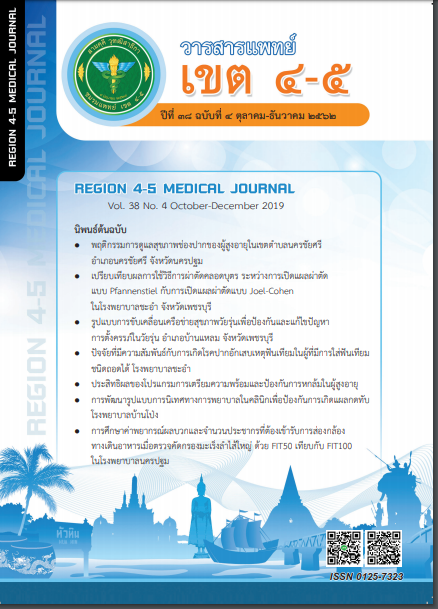การศึกษาค่าพยากรณ์ผลบวกและจำนวนประชากรที่ต้องเข้ารับการส่องกล้องทางเดินอาหาร เมื่อตรวจคัดกรองมะเร็งลำไส้ใหญ่ด้วย FIT50 เทียบกับ FIT100 ในโรงพยาบาลนครปฐม
คำสำคัญ:
การตรวจหาเลือดแฝงในอุจจาระ, การตรวจคัดกรองมะเร็งลำไส้ใหญ่, ค่าพยากรณ์ผลบวก, จำนวนประชากรที่ต้องรับการส่องกล้องทางเดินอาหารบทคัดย่อ
วัตถุประสงค์ : เพื่อเปรียบเทียบค่าพยากรณ์ผลบวก และจำนวนประชากรที่ต้องเข้ารับการส่องกล้องทางเดินอาหาร เมื่อตรวจคัดกรองมะเร็งลำไส้ใหญ่ด้วย FIT 50 เทียบกับ FIT 100
วิธีการศึกษา : เป็นการศึกษาแบบย้อนหลัง ในประชากรอายุ 50-70 ปี ที่ไม่มีอาการผิดปกติ และมีความเสี่ยงต่อการเกิดมะเร็งลำไส้ใหญ่ในระดับปกติในพื้นที่จังหวัดนครปฐม ที่ได้มารับการตรวจคัดกรองมะเร็งลำไส้ใหญ่ด้วย FIT 50 ในปี พ.ศ. 2559 และ FIT 100 ในปี พ.ศ 2560 โดยค่า positive predictive value (PPV), number need to colonoscope และ positive rate, dropout rate จะถูกเปรียบเทียบทางสถิติโดยใช้ chi-square test
ผลการศึกษา : จากการศึกษามีประชากรที่ได้รับการตรวจคัดกรองมะเร็งลำไส้ใหญ่ด้วย FIT 50 ในปี พ.ศ. 2559 จำนวน 4,100 ราย และ FIT 100 ในปี พ.ศ. 2560 จำนวน 6,896 ราย โดยมี FIT positive rate คิดเป็นร้อยละ 12.7และร้อยละ 3.6 ตามลำดับ มีอุบัติการณ์การตรวจพบติ่งเนื้อลำไส้ใหญ่ (colorectal polyp) คิดเป็นร้อยละ 3.0 และร้อยละ 1.1 และมีอุบัติการณ์การตรวจพบมะเร็งลำไส้ใหญ่ (colorectal cancer)ร้อยละ 0.37 และร้อยละ 0.17ของประชากรที่ได้รับการตรวจคัดกรองด้วย FIT 50 และ FIT 100 ตามลำดับโดยมี dropout rate ของประชากรที่ให้ผลตรวจเป็นบวก และไม่ได้รับการส่องกล้องทางเดินอาหารคิดเป็น ร้อยละ 28.9 และร้อยละ 14.9 ค่า positive predictive value (PPV) ของการตรวจ FIT 50 เทียบกับ FIT 100 ในรายที่เป็นติ่งเนื้อลำไส้ใหญ่ คือร้อยละ 34.3 และร้อยละ 30.8 ของประชากรที่ผลตรวจ FIT ให้ผลบวกและเข้ารับการส่องกล้องทางเดินอาหาร ค่า PPV ในการตรวจพบมะเร็งลำไส้ใหญ่คือ ร้อยละ 4.3, 5.7 ค่า PPV ของการตรวจพบติ่งเนื้อและมะเร็งลำไส้ใหญ่ ร้อยละ 38.6, 36.5 ส่วน number needed to colonoscope ของประชากรที่มีผลตรวจ FIT เป็นบวกของ FIT 50 และ FIT 100 พบว่าค่า Number needed to colonoscope ในการตรวจพบติ่งเนื้อ คือ 3, 4 ตามลำดับ Number needed to colonoscope ในการตรวจพบมะเร็งลำไส้ใหญ่ เท่ากับ 24, 18และ numbers needed to colonoscope ในการตรวจพบติ่งเนื้อและมะเร็งลำไส้ใหญ่ของ FIT 50 และ 100 มีค่าเท่ากันคือ 3
สรุป : การตรวจคัดกรองมะเร็งลำไส้ใหญ่ด้วย FIT 100 ng/ml พบว่า มีค่า PPV ที่ไม่แตกต่างกับ FIT 50 ng/ml และมีค่า number need to colonoscope ที่ต่ำกว่าการตรวจด้วย FIT 50 ng/ml จึงเป็นวิธีการคัดกรองที่เหมาะสมกับประเทศที่มีข้อจำกัดด้านบุคลากรและอุปกรณ์ในการส่องกล้องทางเดินอาหาร
เอกสารอ้างอิง
2. Khuhaprema T, Attasara P, Sriplung H, et al. Cancer in Thailand Volume VI, 2004–2006 . Bangkok: National cancer Institute of Thailand, Ministry of public health; 2012.
3. Khuhaprema T, Srivatanakul P, Attasara P, et al. Cancer in Thailand Volume V, 2001–2003. Bangkok:National cancer Institute of Thailand, Ministry of public health; 2010.
4. Imsamran W, Chaiwerawattana A, Wiangnon S, et al. Cancer in Thailand Vol.III, 2010-2012. Bangkok: New Thammada Press; 2015:31.
5. Imsamran W, Pattatang A, Supaatagorn P, et al. Cancer in Thailand Vol.IX, 2013-2015. Bangkok: New Thammada Press; 2018:28.
6. World Health Organization. Cancer control: knowledge into action: WHO guide for effective programmes. Geneva: WHO; 2006-2008.
7. Hewitson P, Glasziou P, Watson E, et al. Cochrane systematic review of colorectal cancer screening using the fecal occult blood test (hemoccult): an update. Am J Gastroenterol 2008;103(6):1541-9. doi: 10.1111/j.1572-0241.2008.01875.x.
8. Van Hees F, Zauber AG, van Veldhuizen H, et al. The value of models in informing
resource allocation in colorectal cancer screening: the case of the Netherlands. Gut. 2015; 64(12): 1985–97. doi: 10.1136/gutjnl-2015-309316.
9. กันต์กมล กิจตรงศิริ, นัยนา ประดิษฐ์สิทธิกร, อุษา ฉายเกล็ดแก้ว, และคณะ. การศึกษาความคุ้มค่าของการตรวจคัดกรองมะเร็งลำไส้ใหญ่และไส้ตรงในประชากรไทย Economic evaluation of colorectal cancer screening among Thai population ภายใต้โครงการศึกษาเพื่อพัฒนาชุดสิทธิประโยชน์ภายใต้ระบบหลักประกันสุขภาพถ้วนหน้า. กรุงเทพฯ: สำนักงานหลักประกันสุขภาพแห่งชาติ; 2557.
10. Halloran SP, Launoy G, Zappa M, et al. European guidelines for quality assurance in colo-rectal cancer screening and diagnosis. First Edition-Faecal occult blood testing. Endoscopy 2012; 44:65-87.
11. Aniwan S, Ratanachu Ek T, Pongprasobchai S, et al. The Optimal Cut-Off Level of The Fecal Immunochemical Test For Colorectal Cancer Screening in a Country with Limited Co-lonoscopy Resources: A Multi-Center Study from Thailand. Asian Pac J Cancer Prev. 2017;18(2):405-12.
12. Hermann B, Simone W. Selecting a Cut-off for Colorectal Cancer Screening With a Fecal Immunochemical Test. Clin Transl Gastroenterol. 2017;8(8) e111.
13. Nielson CM, Petrik AF, Jacob L, et al. Positive predictive values of fecal immunochemical tests used in the STOP CRC pragmatic trial. Cancer Med. 2018;7:4781–90.
14. Shahidi N, Gentile L, Gondara L, et al. Correlating Quantitative Fecal Immunochemical Test Results with Neoplastic Findings on Colonoscopy in a Population-Based Colorectal Cancer Screening Program: A Prospective Study. Can J Gastroenterol Hepatol. 2016;2016:4650471. doi: 10.1155/2016/4650471.

ดาวน์โหลด
เผยแพร่แล้ว
รูปแบบการอ้างอิง
ฉบับ
ประเภทบทความ
สัญญาอนุญาต
ลิขสิทธิ์บทความเป็นของผู้เขียนบทความ แต่หากผลงานของท่านได้รับการพิจารณาตีพิมพ์ลงวารสารแพทย์เขต 4-5 จะคงไว้ซึ่งสิทธิ์ในการตีพิมพ์ครั้งแรกด้วยเหตุที่บทความจะปรากฎในวารสารที่เข้าถึงได้ จึงอนุญาตให้นำบทความในวารสารไปใช้ประโยชน์ได้ในเชิงวิชาการโดยจำเป็นต้องมีการอ้างอิงถึงชื่อวารสารอย่างถูกต้อง แต่ไม่อนุญาตให้นำไปใช้ในเชิงพาณิชย์



